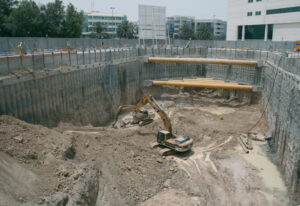2 MAJOR TYPES OF FOUNDATION IN BUILDING CONSTRUCTION
It’s no news that the foundation of a building lends it stability and resilience so that it stands tall amidst whatever challenges. But did you know that the type of foundation you choose for your building construction can have an impact on the quality of your construction project?
IMPORTANCE OF CHOOSING THE RIGHT FOUNDATION
Yes, the type of foundation you choose is a very important aspect in any building construction. It channels the weight of the building to the ground. Beyond this, it helps keep groundwater away from your building construction, and helps balance the overall weight of your structure. If you want to enjoy your structure and be comfortable in it, you must choose aright.
Kagz Projects Limited understands that the role of a structural engineer goes beyond erecting structures. it goes beyond laying bricks and pouring concrete like we talked about in this article
https://kagzprojects.com.ng/the-significance-of-building-construction-in-community-development/
As structural and civil engineers, we’re also tasked with the responsibility of choosing the right footing for your structures and as such, will like to show you the ropes of it as well.
So, how do you get it right?
FACTORS TO CONSIDER WHEN SELECTING A FOUNDATION
Choosing the right footing isn’t just about digging into the ground and pouring concrete. Several key factors must be carefully considered to ensure the stability and longevity of your structure.
These factors help determine the most suitable structural support based on the specific needs of your construction project.
- Topography
- Climate conditions
- Building design and function
- Building size
- Budget
- Level of groundwater in your land
- Soil bearing capacity
- Site use history
With this information, you can now look into the various types of foundations available.
MAJOR CATEGORIES OF FOUNDATIONS
There are two major categories of foundations;
- The Shallow Category
- The Deep Category
This classification is based on the depth of soil in which the structure is built on.
SHALLOW FOUNDATION
So, if you’re looking at constructing a project that’ll be suitable for a factory or one that’ll be used to store metals or anything heavy, you’ll have to look away from using a shallow foundation. But, if you’re looking at constructing a building for residential purposes, or a contract to construct bridges and erect towers, then shallow foundations will work just fine.

There are different types of shallow foundations.
1. Individual Footing Foundation
The individual footing foundation is the most common type of shallow foundation. It’s usually built as a single rectangular, circular, or squared slab with uniform thickness that supports just a single column. This helps distribute the load of the building across a vast region. The size of slab to be built is calculated based on the ground conditions and the load of the building. This set up can be used for small structures up to five storeys high, and is suitable for areas with soft soil or high water table.
2. Raft Foundation
This is commonly used when the soil is unstable. This type of foundation allows the load on the building to be distributed evenly to the entire building’s outer perimeter. The raft is a thick slab of concrete that is supported with steel bars to strengthen the foundation. This type of structure is suitable for multiple storey buildings due to the reinforcement of the steel bars.
3. Strip Foundation
This foundation transfers the weight of load-bearing walls to the ground. It is usually a concrete slab built under walls to transfer the weight of the walls to the gerund. To properly execute this, it is expected that the width of the slab is three times more than that of the wall, and its depth same as the wall’s width. This ensures that the wall’s weight is effectively distributed to the ground.
4. Individual Footings with Ground Beams:
This is a kind of foundation whereby individual columns are connected with ground beams to provide integrity to the construction system.
5. Strip and Pad Foundation:
This is a very common type of foundation where the columns rest on reinforced concrete slabs, while the wall rests on the strips.
DEEP FOUNDATIONS

Unlike shallow foundations that are near the surface of the soil, deep foundations have a great depth beneath the soil surface, transferring the weight of the building to a great depth beneath the ground surface at a ratio greater than four to five meters. Although this type is expensive, it is necessary if the soil bearing capacity is low and the building design is large to promote safety and building integrity.
Under this category, there are some examples such as;
1. Pile Foundation
A pile is simply a constructed cylindrical structure that is made of concrete or any strong material. It is introduced into the deep layer of the ground to provide a steady support for structures that’ll be constructed on top of it. there are two types of pile foundations; end bearing piles and friction piles.
End bearing piles have the end of the piles resting on a hard surface like a rock or a very strong, stable soil. This means that the weight of the building is transferred to the solid support beneath the ground.
Friction piles also transfer the weight of the building to the ground. The deeper the pile, the more weight it can bear. Simply put, the amount of load a pile can bear is directly proportional to its length.
2. Shaft Foundation
This is a cylindrical shaft that is excavated into the ground and filled with concrete. There are four types of shaft foundation; the straight shaft, belled shaft, Underreamed shaft and Socketed shaft.
The straight shaft is a simple straight cylindrical column that is drilled into the ground and concrete poured over it.
The belled shaft has its end shaped like a bell to provide extra support just in case the deep layers are not enough to enhance support.
The underreamed shaft has more widening than the belled shaft to provide additional support against heavy loads
Socketed shaft is one that is drilled into a rock for more support.
3. Caisson Foundation
This is a watertight cylindrical structure that is sunk into the ground at a depth and filled with concrete to provide a stable foundation for structures. It is used in the construction of structures that require foundation beneath rivers or water bodies. The watertight nature of the structure helps keep water out by trapping air outside. This type of foundation is used in the construction of bridges, dorks and other large structures.
4. Basement Foundation
These are like the regular foundations that are constructed underground and support building weight and structure. However, the regular foundations do not provide any spaces because everything is underground and sealed. But the basement foundation walls are fully submerged into the ground and provide usable spaces for an underground floor.
In conclusion, your civil construction project comes with a lot. It is a journey, just as we already discussed in this article, https://kagzprojects.com.ng/the-construction-journey-a-tale-of-the-triumphs-and-trials-of-construction-and-mechanical-engineering/
Your engineer knows the best foundation for your building. It is best to discuss your preferences with the engineer to get the best outcomes for your construction.
